
J Scott Bronson reminiscences about his friend, the late playwright Eric Samuelsen, followed by the text of Eric’s introduction to a reading of Scott’s play Tombs, held at the 2013 AML Conference.
My introduction to Eric Samuelsen was as an audience member attending his play, Playing the Game, at BYU in the Fall of 1982. I was brand new at BYU but already I was making friends in the theater department (you meet a lot of people when you’re in four different shows in one semester), but Eric was not one of them. Eric and I did not meet until the next semester when we were both part of the troupe that trouped off to our region’s Kennedy Center American College Theater Festival in Coeur d’Alene, Idaho. But, still, no friendship kindled there.
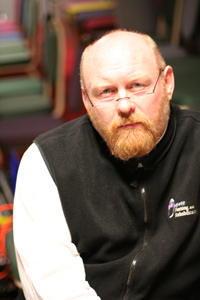
In fact, Eric remained nothing but a dim memory never accessed until he returned to Utah after earning a PhD from Indiana University and teaching for a spell at Wright State University in Ohio. Sometime in the Nineties our paths began to cross again. While he was away, I had become a playwright as well, so now, with both of us practicing LDS playwrights living in Utah Valley, and both of us passionate about Mormon arts and letters, it was inevitable that we would run into each other. Which we did, including on AML-List, an email list service sponsored by The Association for Mormon Letters since 1995. In those very early days of social media (possibly before that term had even been coined!) there was delicious urgency in coming home from work and going right to the computer to see how the conversation had evolved that day. To see if anyone had said something outrageous or half crazy. To see if anyone responded to my review or that one really pithy comment I made on that one thread. And to see if — hang on! Who does this guy think he is?! It was exciting and nourishing and because of it I met several very fine human beings who became very dear to me and remain so to this day.
Eric is one of those people.
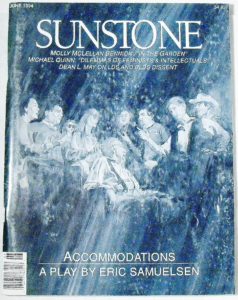 Over the years since then we’ve had a few opportunities to work together. In 1993 I was in the premiere production of Accommodations at BYU. In his very kind thank you note to me, he shared a concept I’d not encountered before but immediately made my new credo: Attack the culture; defend the faith.
Over the years since then we’ve had a few opportunities to work together. In 1993 I was in the premiere production of Accommodations at BYU. In his very kind thank you note to me, he shared a concept I’d not encountered before but immediately made my new credo: Attack the culture; defend the faith.
In 2003, halfway through the one and only season of the Nauvoo Theatrical Society — of which I was a founding member with my partner Thom Duncan, and of which I was the artistic director — Eric, in his always generous efforts to support almost any LDS oriented theater venture — directed his play (royalty free), The Way We’re Wired. My wife, Lynne, and I got to play the romantic leads opposite each other. What a blast that was. Eric said we were better than the Lunts (IYKYK).
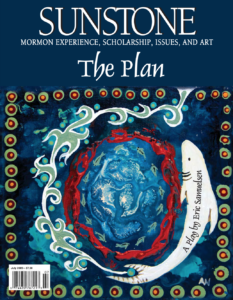 A few years later, when I was the artistic director for the Brinton Black Box Theater at the Covey Center for the Arts in Provo, I arranged to work with Eric a couple more times. One season he directed his play, The Plan, and another season I convinced him to write a one-act play for us. That Valentine season I put together an evening of Blind Dates with Horton Foote’s one-act as the anchor with three other one-acts by me, Melissa Leilani Larson and Eric. When I asked him if he’d write one for us, his only question was, “What are the guidelines?” I told him all four plays needed to have the same title and
A few years later, when I was the artistic director for the Brinton Black Box Theater at the Covey Center for the Arts in Provo, I arranged to work with Eric a couple more times. One season he directed his play, The Plan, and another season I convinced him to write a one-act play for us. That Valentine season I put together an evening of Blind Dates with Horton Foote’s one-act as the anchor with three other one-acts by me, Melissa Leilani Larson and Eric. When I asked him if he’d write one for us, his only question was, “What are the guidelines?” I told him all four plays needed to have the same title and 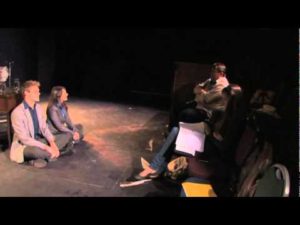 no more than four actors, other than that, no guidelines. He turned in a brilliant little piece with two actors, a man and a woman, sitting on the floor talking. It took the audience about six or eight minutes to figure out the actors were playing seeing eye dogs in a restaurant with their owners. Peeking through the curtains to see audience members achieve that “ah-ha!” moment was a lot of fun. Eric also directed that production.
no more than four actors, other than that, no guidelines. He turned in a brilliant little piece with two actors, a man and a woman, sitting on the floor talking. It took the audience about six or eight minutes to figure out the actors were playing seeing eye dogs in a restaurant with their owners. Peeking through the curtains to see audience members achieve that “ah-ha!” moment was a lot of fun. Eric also directed that production.
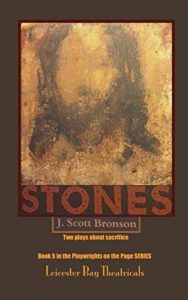 I sit out on the fringes of the LDS arts community, friends with some of the stars in the show, occasionally tossing something into the mix, contributing a little to the conversation. When my play, Tombs (a story of Mary, Jesus and Joseph, and the second of the two one-acts — the first is Altars — together they are called Stones) was chosen to be part of the opening exercises of the AML conference several years ago, Eric agreed to offer an introductory essay. I was terrified and thrilled at the same time. I admired, and was often astounded by, his keen mind and quick, sharp wit. His capacity for instant and deeply probing analysis boggled my mind. Having his take on one of my works not only filled me with trepidation at the time, it was an honor I shall always treasure.
I sit out on the fringes of the LDS arts community, friends with some of the stars in the show, occasionally tossing something into the mix, contributing a little to the conversation. When my play, Tombs (a story of Mary, Jesus and Joseph, and the second of the two one-acts — the first is Altars — together they are called Stones) was chosen to be part of the opening exercises of the AML conference several years ago, Eric agreed to offer an introductory essay. I was terrified and thrilled at the same time. I admired, and was often astounded by, his keen mind and quick, sharp wit. His capacity for instant and deeply probing analysis boggled my mind. Having his take on one of my works not only filled me with trepidation at the time, it was an honor I shall always treasure.
Eric Samuelsen’s introduction of J Scott Bronson’s play Tombs
AML Conference, UVU Library Auditorium, March 29, 2013
I stand before you, on this Good Friday, to talk about a play. A play, as it happens, written by one of my dearest friends. I’ve seen the play in production; I regret that I will not be able to stay to see it tonight. But I want to begin in a place a long time ago, and a long way off. The towns of York and Wakefield and Chester in the North of England, sometime in the fourteenth and fifteenth centuries. It’s June, and spring harvests are in. Nights still a bit chilly, days crisp and clear and warmed by the sun. A parade has begun, and the priest carries before him a holy wafer and a vial of wine. Perhaps we hear a song in Latin “Oh, salutaris hostia,” sung in perfect, four-part harmony. Tonight, there will be a feast; today, a parade, and performances.
The feast of Corpus Christi begins on the Thursday six weeks following Easter; six weeks, that is, after Maundy Thursday. Corpus Christi is Latin for the “Body of Christ.” The Feast day celebrates the Eucharist, the real presence of Christ in the elements of the host—the body and blood of Christ. Holy wafers and wine, in the Catholic tradition. Tap water and Wonder Bread, in the Mormon faith. Served by twelve year olds, their shirts too big for their necks, clip-on ties askew. Every Sunday, at mass, back then, we’d take the sacrament; as Catholics still do. But in addition, an annual holiday celebrated the host itself. Corpus Christi is primarily a Catholic feast day, though some denominations in the Anglican tradition also celebrate it. We Mormons don’t bother with it. About the only Holiday we worry about in June is also about Fathers: when we get our Dads a tie or some cologne. But for Catholics, 13th through 16th centuries, Corpus Christi was a major holiday, and a fun one.
The idea for Corpus Christi came from a woman, Juliana of Liege, an orphaned child-turned nun, who had a vision of the moon, darkened by a spot, signifying, in her mind, a deficiency in the liturgical calendar. She suggested that in addition to the weekly Eucharistic service, that a special feast day be established just to celebrate that Sacrament, and the miracle of transubstantiation. Pope Urban IV eventually established Corpus Christi as a feast day in 1264.
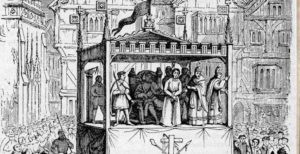 One of the main ways in which the Feast of Corpus Christi was celebrated was through the performance of plays. That may seem a little strange at first, until we interrogate the practice. Although we Mormons don’t share with Catholics their belief in the doctrine of transubstantiation, which is at the heart of Corpus Christi, we also practice it, do we not? In this miraculous art form we call theatre? In transubstantiation, the substance of sacramental bread literally becomes flesh, and wine becomes blood. Well, what do actors do, but take upon themselves, with the aid of some greasepaint and a costume piece, literally flesh out, provide flesh to, an idea, an abstraction, a series of constructions of language. Dramatic characters, living human souls, enacting a story, for our edification and enjoyment.
One of the main ways in which the Feast of Corpus Christi was celebrated was through the performance of plays. That may seem a little strange at first, until we interrogate the practice. Although we Mormons don’t share with Catholics their belief in the doctrine of transubstantiation, which is at the heart of Corpus Christi, we also practice it, do we not? In this miraculous art form we call theatre? In transubstantiation, the substance of sacramental bread literally becomes flesh, and wine becomes blood. Well, what do actors do, but take upon themselves, with the aid of some greasepaint and a costume piece, literally flesh out, provide flesh to, an idea, an abstraction, a series of constructions of language. Dramatic characters, living human souls, enacting a story, for our edification and enjoyment.
Initially, Corpus Christi started with a parade honoring the elements of the host, but in time, plays were written and performed by the guilds of the community—the solid backbone of Christian society, the tailors and bakers and nailmakers and cobblers and wheelwrights. The plays they wrote have survived, especially in England. We call them Mystery Plays, perhaps to celebrate the twin mysteries of Incarnation and Atonement, in which God became Man, and later died for our sins.
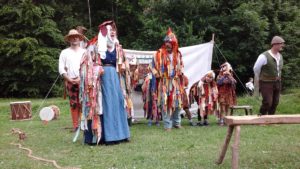 Joseph of Galilee was a favorite character in the plays of Corpus Christi. The unidentified and anonymous authors of the these plays understood something fundamental about drama; that comedy and tragedy are not competing, but complementing masks and styles. Noah is a doddering old buffoon, his dottiness juxtaposed against the shrieks of drowning neighbors. Herod’s soldiers are drunks. And even the soldiers crucifying our Lord are comedically bad at their jobs. We’re allowed to laugh, just before we’re invited to weep. Astonishingly, shockingly, the plays still work in production. And are still frequently produced.
Joseph of Galilee was a favorite character in the plays of Corpus Christi. The unidentified and anonymous authors of the these plays understood something fundamental about drama; that comedy and tragedy are not competing, but complementing masks and styles. Noah is a doddering old buffoon, his dottiness juxtaposed against the shrieks of drowning neighbors. Herod’s soldiers are drunks. And even the soldiers crucifying our Lord are comedically bad at their jobs. We’re allowed to laugh, just before we’re invited to weep. Astonishingly, shockingly, the plays still work in production. And are still frequently produced.
Joseph, Jesus’ earthly father, is a comic figure as well. He’s old, a senile and feeble cuckold. The ‘foolish old man, married to a younger woman’ would become a staple of Moliere, of Cervantes, of commedia dell’arte and TV sitcoms. And in the York version of Corpus Christi, the play of the Annunciation, performed by the pewterers and metal-workers guild, Joseph contemplates suicide.
The purpose of the Corpus Christi plays was to humanize the characters of the Bible, to make them accessible. Since the liturgy was in Latin, most congregants likely went through Sunday services in a bit of a daze. Stained glass windows served as a nice aid to communication. So did acting; and some priests became as adept at chewing the scenery as in administering the wafer and wine. But so did these annual exercises in community theatre, which were not in Latin, but in the vernacular, in the robust and blunt Middle English of Northern Britain. The point was to point up the shared values of the entire town, to celebrate together the hard-won spirituality of the late Middle Ages. When we read about medieval Christianity, what strikes us are its heresies; the mortification of the flesh, the violent sexism and anti-Semitism. The violence: period. Products, perhaps, of a culture too close to death, too used to instant, sudden, inexplicable annihilation.
But we can relate to the plays. The plays and the music and the cathedrals—the products of genuine devotion—we can look there, and feel the same kinship and wonder we feel in holy places today; the caves of Lescaux, and the temples of India, and Tenochtitlan and Machu Picchu, or in concert halls, listening to Mahler’s Resurrection Symphony or Barber’s Adagio for Strings. That sense of shared humanity and reverential adoration.
And here, tonight, at UVU. In Tombs, Scott Bronson shows us a very different Joseph, the kind and caring father to whom our Heavenly Father entrusted his Only Begotten. Joseph has just died, in fact–though we flash back to catch a glimpse of his parenting style–and Mary and Jesus mourn together [inside] his tomb.
But in many respects, Tombs reflects the same impulse that drove the plays of Corpus Christi. It tells us the story of our faith. It reorients us towards our theology, towards the beliefs that center us and define us. It reminds us of what we hold most dear.
It’s a deceptively simple play, really. A mother and son mourn together, and she presses him to tell her his plans. They share memories. He has an upcoming task that he dreads—she presses him to let her share his burden.
As I re-read the play once again this morning, that word came back to me—burden. In a very real sense, Scott has written a play about unburdening. Through confession and conversation, through memories and recollections. Through atonement. These characters, so familiar, and yet also doctrinally distanced from us, unburden themselves to each other. As we literally unburden, pass on our burdens, of sin and pain and regret and error, to our Savior, who then chooses to bear them himself, for us, out of love. And the play ends with two words, the two words above all others, all Christians wish we could speak. Thank you.
Juliana of Liege saw a flawed and incomplete moon, and sought to fill it with a celebration. And communities and towns across the medieval Catholic world enhanced that celebration by writing and rehearsing and designing and directing and building and performing deceptively simple plays, reflecting the profoundest stories and beliefs at the heart of their culture. Scott Bronson has done the same here. He reminds us what must never be forgotten; he speaks for and to our culture of our most central and enduring shared faith. He makes The Word flesh, he theatrically transubstantiates. He places us [inside] a tomb, and reminds us of a tomb found empty, and how that emptiness fills our hearts. He nourishes us with the bread of mimesis.* From the Guild of Scribblers and Thespians, we bring you our fondest story. We share with you: Tombs.
*representation or imitation of the real world in art and literature.
About Eric Samuelsen, please see the eight-volume The Collected Plays of Eric Samuelsen and his AML obituary. About J Scott Bronson, see his Stones: two plays about sacrifice, his novel The Agitated Heart, and a 2008 interview at Mormon Artist.
